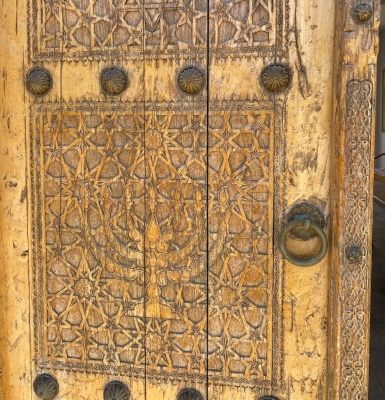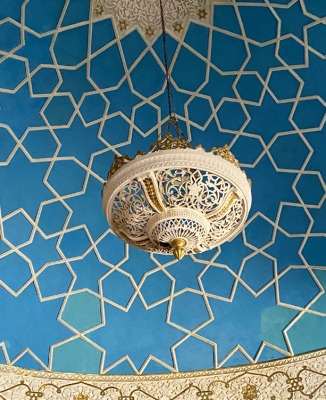Jewish Roots On The Silk Road
Text and Photos by Debbie Sinai
The Silk Road has held intrigue and allure for many decades, centuries, and millennia. I was fascinated by what history, art and magnificent architecture it held and what I was going to experience by travelling to Uzbekistan, which was one of the main countries on the ancient Silk Road. Asia seemed so far away, so full of legends and especially exotic history. To me, The Silk Road represented not only universal commerce, but also human contact and interactions, creating connections between civilizations, and the exchange and influence of cultures, traditions and religions. (Quite in a nutshell!).
The Silk Road began thousands of years before the Common Era and lasted until the 15th and 16th centuries. It encompassed huge geographical areas, from China to Europe, witnessing kingdoms that rose and fell; wars and conquests; religions that were born and those that were abandoned and some that were absorbed into new ones sprouting in the region.
Jews were always active in commerce and trade, throughout history. So, I deduced, there must be something "Jewish" about the Silk Road. Although I did not succeed in discovering that the Jews were active in commerce on the Silk Road, I did enjoy and appreciate witnessing the presence of Jewish traders on the route throughout its history. They influenced and were influenced by customs and artistic designs and motifs from its contemporary religions and civilizations. And so, I did not change the title of my article, because the Jewish Roots are indeed there, although not at the very beginnings.
Our travels took us first to the Ancient Walled city of Khiva, one of the most northern routes on the Silk Road, before the vast desert looms ahead. Although I did not encounter any indication of Jewish activity, I found a building decorated with a Magen David. However, the 6-pointed star was a popular motif in many oriental cultures.
Buchara, however, boasted a large Jewish population, and we found two synagogues. The first, we found by chance. Why had Jews settled there if not for livelihood and commerce? We walked to the large Buchara Jewish Cemetery, the graves of which are in place in the ground behind a large beautiful building of offices topped with a shimmering turquoise dome one can see from a distance. Many of the tombs are very old, and on some of them, the carved inscriptions are now illegible. The more modern tombs have large headstones with inscriptions in Russian and in Uzbek and with photos of the deceased as in the Russian tradition. There is no English. The whole atmosphere is sullen, with earth color dominating the tombs. There is no grass or greenery, and in the distance, the desert can be seen.
On our way to the cemetery, we passed a street - they call it a street, but in our terminology, this narrow walkway, half paved and half dirt road, would be called more of an alley. This street had a sign: "Shalom Aleichem Street" in Uzbek and Russian. I could make out the letters and understand.
I said there must be a synagogue there! Leaving the cemetery, and crossing the huge thoroughfare with cars driving each its own way (there are no lanes and cars drive randomly, on a very wide road), we walked the length of Shalom Aleichem St. and didn't find a synagogue. However, arriving at the end, a taxi suddenly drove up. (Taxis are small General Motors Compact Cars assembled in Uzbekistan). A young woman alighted from the taxi, and I asked the driver if he knew where the "Synagoga" is. He didn't speak or understand English, but "Synagoga" he understood. He drove us a bit further along the alley until it became too narrow even for the compact car, and indicated where the Synagoga was. We continued a few meters by foot, and found the very old synagogue. It is no longer in use. There was no dedication date we could see, but it is considered an historic State edifice.
The synagogue in use in Buchara dates from the 16th century. There is an adjacent Jewish Community center, housed in an "Old Jewish Buchara home" dated 17th-18th centuries. The buildings were closed when we were there. They emanate from a side street in the main center of Buchara with a large courtyard, called Labi-Hauz.
Samarkand is very imposing, very religious and very traditional. It boasts beautiful Islamic architecture replete with stupendous mosaic tile work. Samarkand became an imposing center of Islam, and the artistic decorations influenced edifices of every religion.
The synagogue in Samarkand is large and impressive. Synagoga Gumbaz was built in the 19th century. Gumbaz means "Dome", and indeed, it has one. Its woodwork is elaborately carved, and the "Bimah" and interior are intricately sculpted, painted and decorated. There is a picture of our chef Aharoni's grandfather on the wall together with those of the other founders of the Gumbaz Synagoga, and I couldn't get over the amazing resemblance between the two of them.
Travelling in Asia was a new and unique experience for me. Searching for Jewish roots was challenging, and interesting. The ancient roads and edifices that remained were not only witnesses to the cultures that were created and thrived in what is now Uzbekistan but also what the Russian occupation brought – its values, patterns, architecture, and way of life.
Although Uzbekistan is now independent, all of these influences remain, making the country both ancient and modern and full of exotic history.
I thank my husband Aharon, for initiating our trip there, and for his expert planning.











Comments